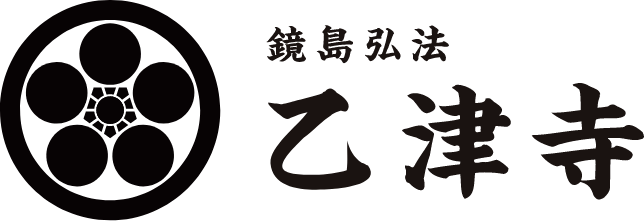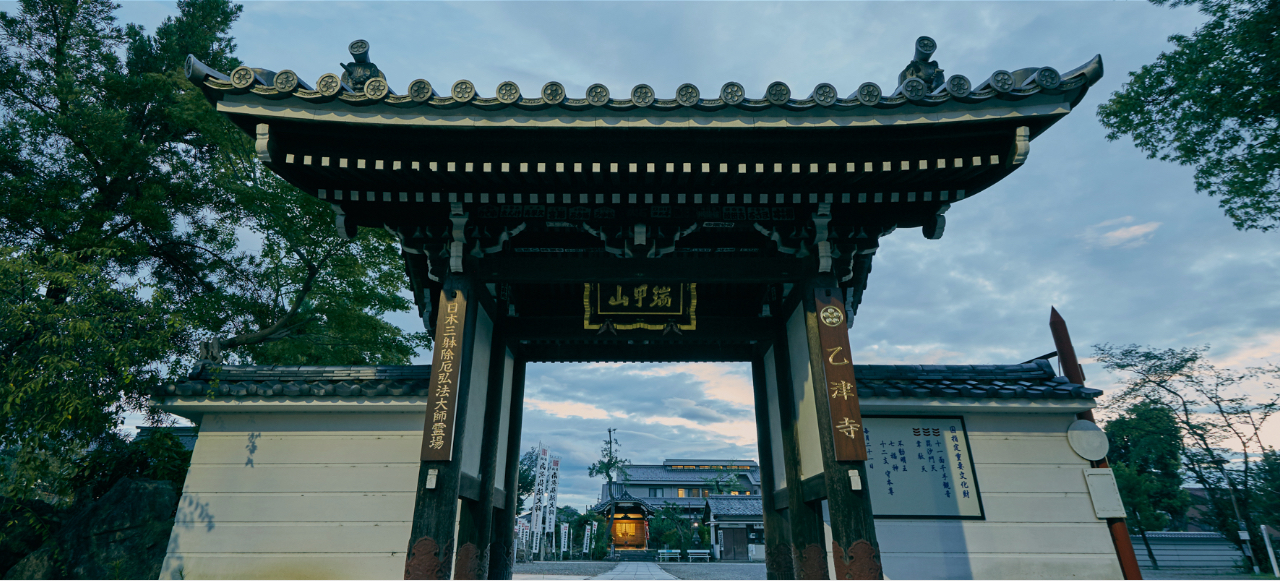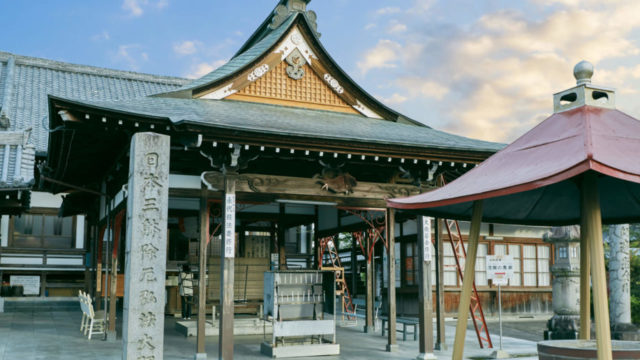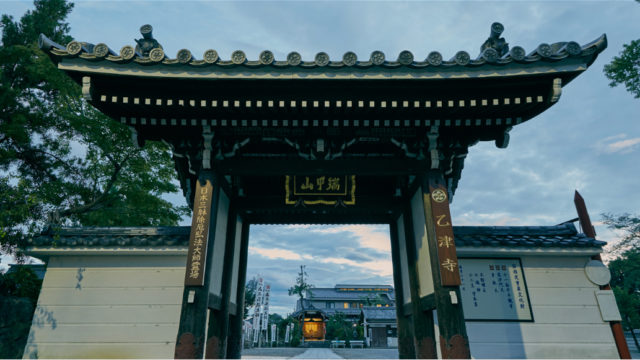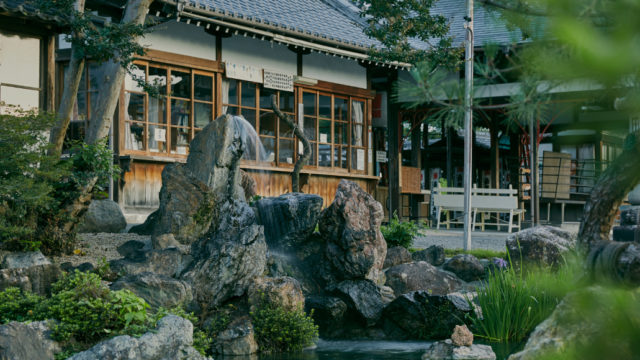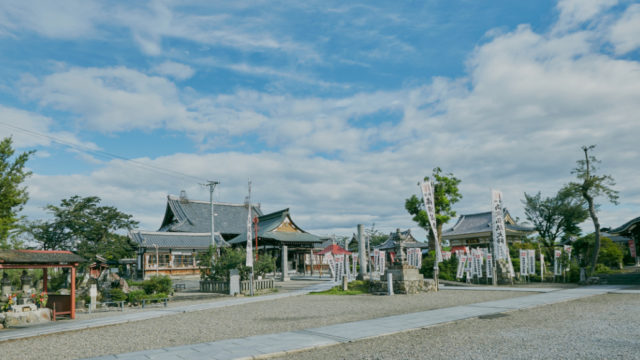Deeply Related to Kōbō Daishi
Zuikōzan Osshinji is a Buddhist temple located in Kagashima, Gifu City. Dating back to the Nara Period (710-794), the temple originates from a thatched hut where Gyōki, also referred as Gyōki Bosatsu (Bodhisattva Gyōki) enshrined a self-made statue of Jūichimen Senju Kannon Bosatsu (Eleven-faced, Thousand-armed Deity of Mercy). Due to its deep association with Kūkai (Kōbō Daishi), the temple has been familiarly known as “Kagashima Kōbō.”
Greetings

Hoping to Become Your Anchorage
Weaving more than 1200 years of history since the Nara Period (710-794), the Osshinji Temple has been affectionately called “Kagashima’s Kōbō-san” by the local people. The temple is located in an area that is rich in nature: its compound is full of greenery including ume (Japanese plum tree) that is closely related to Kōbō Daishi and the sacred kusunoki (camphor tree), and the clear Nagara River flows continuously just north of the temple.
On the 21st of every month, we conduct a memorial service to commemorate the death date of Kōbō Daishi. This is the time when we have a greater turnout of visitors as an ennichi festival is also held on the sidelines with a lot of street stands lined up alongside the approach up to the compound.
We believe that temples should be places that are open widely to the public. Therefore, it would be a great delight for us to see many people, regardless of their sects and schools, young and old, and even small children visiting the temple and attaining peace of mind. We will remain devoted further to sincerely listening to the prayers and voices of visitors so that they can turn to our temple for emotional support whenever necessary. We sincerely hope to be loved by everyone and play an indispensable part for society.
Umezono Takahide
The 22nd Head Priest
Zuikōzan Osshinji
Origin, History, and Tradition
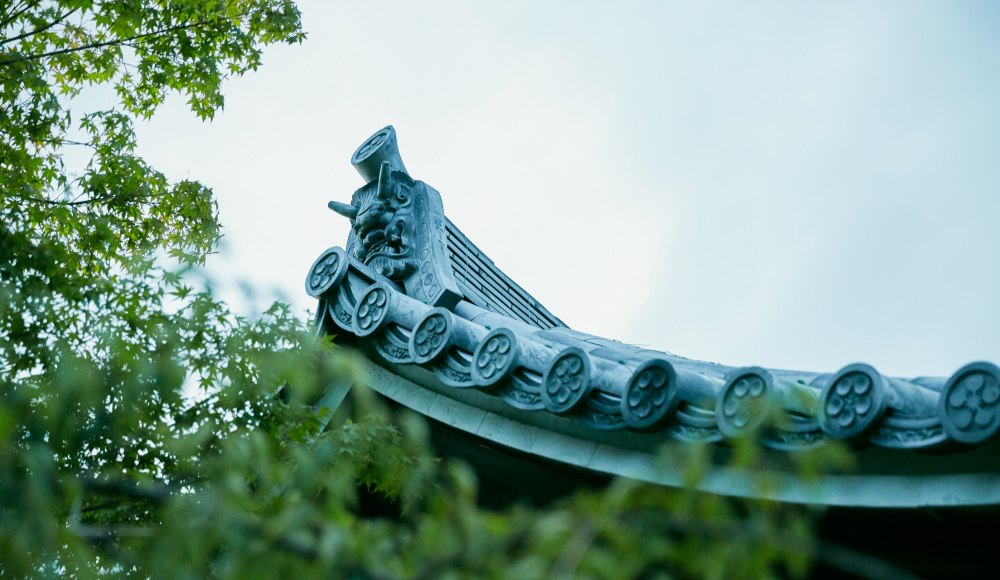
Gyōki Bosatsu Created the Foundation and Kōbō Daishi Established the Temple
The origin of this temple is said to date back to 738 when Gyōki Bosatsu arrived in a small island named “Osshinto.” On this island, he carved a statue of Jūichimen Senju Kannon Bosatsu (Eleven-faced, Thousand-armed Deity of Mercy) and enshrined it in a thatched hut.
In later years, Kōbō Daishi (the high priest Kūkai), the founder of this temple, arrived in this island in 813, and performed an exhaustive 37 days of esoteric rituals. Dedicatedly praying, he held the magical mirror up to the Dragon God, then the ocean turned into mulberry fields. Because of this legend, this area came to be called Kagashima (Mirror Island), and the temple was named Osshinji after Chinju Osshin (the indigenous Deity of Osshinto).
In addition, Kōbō Daishi established a complex of seven temple buildings, five sub-temples, and Chinju (the shrine for the indigenous Deity), etc. within 3 years under the Imperial order of Emperor Saga, and carved his own statue. He also planted a staff made from ume (Japanese plum tree) in front of the main hall, saying, “If the teachings of Buddhism prevail here, this staff will grow its branches and leaves abundantly.” The wonder is that a lot of branches and leaves grew out instantaneously on the staff. Based on this legend, the temple is also dubbed as “Umedera (Temple of Ume).”
The Castellan of Kagashima Castle Restores the Temple as Part of the Myōshinji School of the Rinzai Sect
In the medieval times, the temple was in jeopardy of obsolescence due to a series of wars and natural disasters such as floods. In 1549, however, then castellan of Kagashima Castle, Ishiko Suruga-no-kami Mitsukiyo restored the temple buildings. In addition, he invited a Zen master, *Koyū Sōshun from the Myōshinji Temple located in Kyoto, and initiated a common dojo (training center) for Zen Buddhism and Esoteric Buddhism. Since then, this temple has been part of the Myōshinji School of the Rinzai Sect in Zen Buddhism. Mitsukiyo’s grave (five-ringed pagoda) can be found even today near the entrance to the temple. This pagoda is flanked by a couple of gravestones that have the year 1554 engraved on them.
*Koyū Sōshun was the 10th generation from Musō Taishi (the first head priest of the Myōshinji Temple), and granted a posthumous title of Daien Reikō Zenji from the Imperial Court.
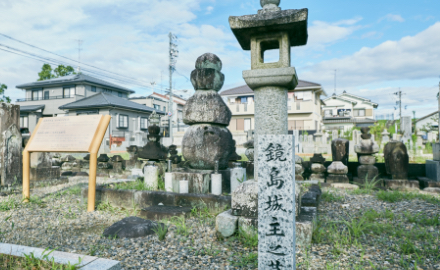
One of the Oldest Graves in Gifu
TheOsshinji Temple became devastated by a flood on the Nagara River in 1540 but restored by then castellan of Kagashima Castle, Ishiko Suruga-no-kami Mitsukiyo in 1545. The family grave of the Ishiko Clan (five-ringed pagoda) is situated in front of the temple gate, and regarded as one of the oldest graves found in Gifu Prefecture.
Restoration Efforts after World WarⅡand the Donation of the Dragon and Clouds by the Master Artist, Dōmoto Inshō
In 1945, amid World WarⅡ, Gifu was destroyed in air raids, and most of the buildings in the temple burned to the ground. However, the statue of Kōbō Daishi and other Buddhist images were evacuated to the bank of the Nagara River and survived the air raids. Thanks to this, the light of teachings of Kōbō Daishi has been handed down to the present.
In later years, the Daishidō hall was reconstructed in 1958, and the master artist, Dōmoto Inshō, 67 years old at that time, donated his ink painting, “the Dragon and Clouds” for its ceiling. He later received the Order of Culture in 1961.
As the ruler of water, the Dragon God is believed to dispense and irradiate the teachings of Buddhism over the entire world and protect the building from fire. The master artist also donated a fusumae (sliding screen painting) titled, “Transcending the Sky” and a scroll painting of “Fudōson (Immovable King of Brightness).”
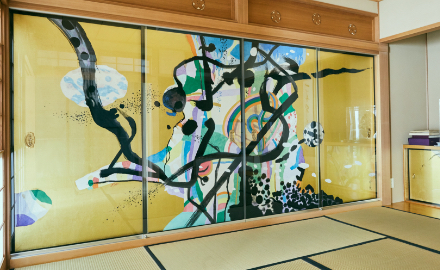
The Sliding Screen Painting and the Ceiling Ink Painting Created by Japan’s Picasso
The temple stores the paintings created by the master painter, Dōmoto Inshō, also dubbed as “Japan’s Picasso”: the sliding screen painting titled “Transcending the Sky” stored in the drawing room, and the ink painting, the “Dragon and Clouds” drawn on the ceiling of Daishidō.
- 738
Gyōki Bosatsu (Bodhisattva Gyōki) carves a statue of “Jūichimen Senju Kannon Bosatsu” (Eleven-faced, Thousand-armed Deity of Mercy) and enshrines it in his self-made thatched hut.
- 813
Kōbō Daishi (Kūkai) arrives in Osshin Island upon the Imperial order of Emperor Saga and establishes the Osshinji Temple.
- 894
Emperor Uda grants the temple a plaque that read “Reibaijō (Place of the Sacred Plum),” which leads it to earn a status as an Imperial seminary to pray for the protection of the nation. The plaque is burned down in a war during the period of 1504-1521 but the stone monument inscribed with the word, “Gejō (Dismount the Horse)” and the Buddhist memorial tablet of Emperor Uda still remain in the temple.
- 1338~1342
Toki*Danjō-Shōhitsu Yoritoo becomes Sōryō (the head of the Toki clan), and forfeits the estate of the temple that extends the whole Kagashima area, but he later donates two hundred koku (unit of rice yields) to the temple in order to protect it as a place to pray for the prosperity of the successive Shugo (provincial constables) of Mino Province
*Assistant Chief of the Security Office
- 1473
Ichijō Kaneyoshi, a court noble and a notable scholar, visits Mino from Nara instead of moving back to Kyoto as it has been in the midst of the Ōnin Rebellion (1467-1477). He also visits the Osshinji Temple as well.
- 1540
A major flood occurs in summer, causing enormous damage to the treasure hall as well as many items stored in it including old, historical documents. In addition, Saitō Dōsan, a feudal lord in Mino Province, raises a rebellion, which results in the temple falling into a decline.
- 1545
Ishiko*Suruga-no-kami Mitsukiyo, then castellan of Kagashima Castle, restores the temple buildings. In addition, he invites a Zen master, Koyū Sōshun from the Myōshinji Temple in Kyoto in order to have him serve as the first head priest. Since then, this temple has been part of the Myōshinji School of the Rinzai Sect in Zen Buddhism. The second head priest of the Osshinji Temple, Ranshuku also serves as the 53rd head of the Myōshinji Temple in later years.
*Governor of Suruga Province - 1584
Toyotomi Hideyoshi issues to the temple the “*Chikuzen-no-kami Hideyoshi Kōshōjō” in order to permit the temple’s estate holdings as well as ensure its safety and security.
*The official authorization letter with a red seal issued by Toyotomi Hideyoshi as the Governor of Chikuzen Province - 1601
Kagashima turns into a battle field during the Gōdo River (the present Nagara River) War. During the war, some military commanders, such as Kuroda Nagamasa, Tanaka Yoshimasa, and Tōdō Takatora, stop by the temple to quench their thirst, and pray for the victory of their Eastern Army.
- 1809
Inō Tadataka, the creator of Japan’s first map, stops by the temple to take a survey of the area. In his diary, he touches on Kagashima and the Osshinji Temple in the middle of the Edo Period such as the ruin of the castle once resided by the clan of Ishiko Surugano-kami as well as the Japanese poem created at the temple by the renga (linked poem) master, Sōgi.
- 1873
An elementary school named Kantōgikō is established within the temple’s compound. This school later becomes Kagashima Elementary School in 1898.
- 1891
On October 28th, the Great Nōbi Earthquake occurs and devastates Gifu and Aichi Prefectures. The Osshinji Temple also suffers enormous damage with most of its buildings destroyed in the earthquake.
- 1914
Jūichimen Senju Kannon (Eleven-faced, Thousand-armed Deity of Mercy) and Bishamonten (Heavenly Deity of Warriors and Punisher of Evil-Doers) are designated as national treasures on August 25th.
- 1925
The statue of Idaten (Swift-footed Heavenly Guardian Deity) is designated as a national treasure on April 14th as well.
- 1945
On the night of July 9th, Gifu City is destroyed in formation bombing conducted by B-29 of the U.S. Air Force amid World WarⅡ(known as the Gifu Air Raids). Although the temple’s 4 major images (Kōbō Daishi, Jūichimen Senju Kannon, Bishamonten, and Idaten) survives the attacks, almost everything else is burned down, including the main hall, the Daishidō hall, the priests’ living quarters, the treasure hall, the bell gate, the temple gate, and the Imperial Envoys gate as well as all of old documents and historical materials.
- 1952
In October, a new treasure hall is established with a grant from the Japanese government, the first case in Japan.
- 1955
The construction of the new Daishidō hall starts. It is completed in the fall of 1958. When the hall is restored, the master artist, Dōmoto Inshō (a member of the Imperial Arts and Crafts Experts, and a recipient of the Order of Cultural Merit) visits the temple and draws an ink painting titled, the “Dragon and Clouds” on the ceiling of the new Daishidō hall for donation to the temple.
- 1972
Dōmoto Inshō donates a scroll painting of “Fudōson (Immovable King of Brightness)” to the temple.
Honzon
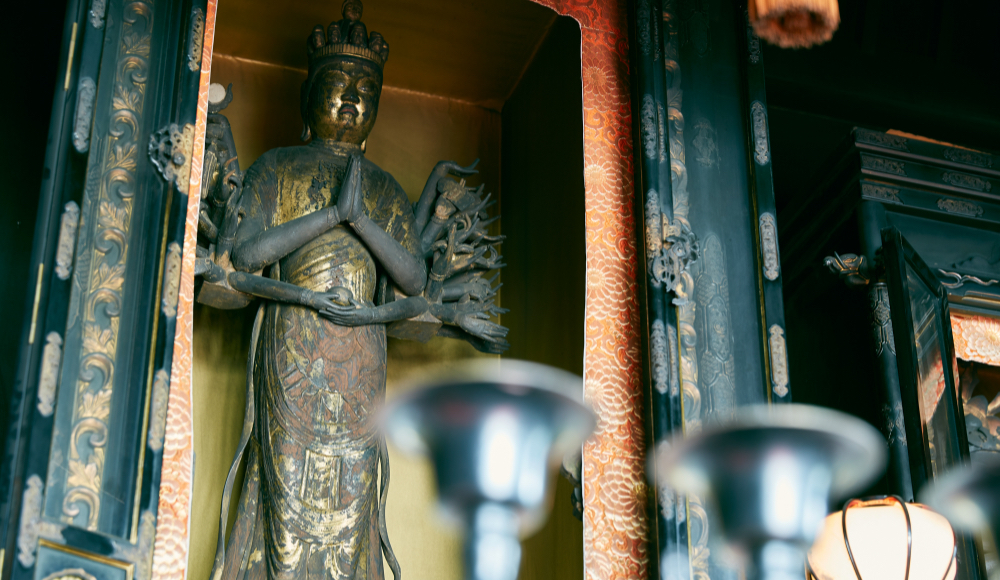
Kannon-sama (Deity of Mercy) Saves All Living Things
Honzon or Gohonzon refers to the image of Buddha or principal Deity enshrined in the center of the temple’s main hall as the most important subject of worship. The Gohonzon of the Osshinji Temple is Jūichimen Senju Kannon Bosatsu (Eleven-faced, Thousand-armed Deity of Mercy) that is designated as a national important cultural property. Carved back in the Tempyō Period (the 700s), this image still exists over a period of more than 1200 years. Each of its eleven faces expresses human emotions of delight, anger, sorrow and pleasure while each of its 40 arms extending on both sides is said to save the beings of the 25 Buddhist worlds This image is normally kept in secret in the treasure hall but becomes open to the public on the 21st of every month, on the days of the ennichi festivals.
Temple Information
| Name | Osshinji Temple |
|---|---|
| Location | Kagashima Naka 2-8-1, Gifu City, Gifu Prefecture, 501-0124, JAPAN |
| Telephone Number | +81-58-252-2062 |
| Sango (honorific mountain prefix) | Zuikōzan |
| Sect | Rinzai Sect Myoshinji School |
| Main Image | Jūichimen Senju Kanzeon Bosatsu |
| Year of Origin | 738 |
| Originated by | Gyōki |
| Founder of the Temple | Kūkai (Kōbō Daishi) |
| Year of Restoration | 1545 |
| Restored by | Ishiko Suruga-no-kami (Governor of Suruga Province) Mitsukiyo, Koyū Sōshun (First Head Priest) |
| Byname | Kagashima Kōbō, Kagashima-no-Kōbō-san Umedera (Temple of Japanese Plum) |
| Pilgrimage Site Number | Tōkai 36 Fudōson Temples No. 31 Shin-Shikoku 88 Temples No.44 Mino Saigoku 33 Temples No. 19 |
| National Important Cultural Properties | Wooden Standing Statues of Jūichimen Senju Kannon Bosatsu (Eleven-faced, Thousand-armed Deity of Mercy), Bishamonten (Heavenly Deity of Warriors and Punisher of Evil-Doers) and Idaten (Swift-footed Heavenly Guardian Deity) |
Learn More about the Osshinji Temple
